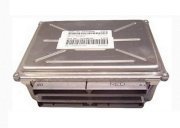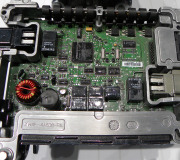The fuel system has a fuel pump relay (part of constant control relay module (CCRM)) controlled by the powertrain control module (PCM), which provides power to the fuel pump under various operating conditions.
When the ignition switch is in the OFF position:
The powertrain control module (PCM) and fuel pump relays are not energized.
When the ignition switch is first turned to the RUN position:
The powertrain control module (PCM) power relay is energized.
Power is provided to both the fuel pump relay and to a timing device in the powertrain control module.
The fuel pump is supplied power by the fuel pump relay.
If the ignition switch is not turned to the START position:
The timing device in the powertrain control module will open the ground Circuit 57 (BK) (after approximately one second). Opening the ground circuit de-energizes the fuel pump relay, which in turn de-energizes the fuel pump. This circuitry provides for pre-pressurization of the fuel system.
When the ignition switch is turned to the START position:
The powertrain control module operates the fuel pump relay to provide fuel for starting the engine while cranking.
After the engine starts and the ignition switch is returned to the RUN position:
Power to the fuel pump is again supplied through the fuel pump relay.
The powertrain control module senses engine speed and shuts off the fuel pump by opening the ground circuit to the fuel pump relay when the engine stops or is below 120 rpm.
The fuel pump module is mounted in the module retainer. The fuel initially enters the module through a flapper valve, located at the bottom of the module, and primes the fuel pump. A portion of the high pressure flow from the pump is diverted to operate a venturi jet pump. The jet pump draws fuel from the tank into the module. This design permits fuel pump operation during vehicle maneuvers and driving on steep hills with low-tank full levels.
This assembly includes a check valve which is inside the manifold outlet of the fuel pump module. The function of this valve is to maintain pressure in the system after the vehicle is shut down.
The pressure retention helps prevent hot starting concerns.
The fuel pump for the:
3.0L MFI. 3.8L MFI and 3.2L SHO is capable of supplying 60L (15.8 gal) of fuel per hour at 269 kPa (39 psi).
3.0L SHO engines are capable of supplying 110L (29 gallons) of fuel per hour at 269 kPa (39 psi).
3.0L FF vehicle is capable of supplying 145L (38 gal) of fuel per hour at 269 kPa (39 psi).
The fuel pump has an internal pressure relief valve to provide overpressure protection in the event the fuel flow becomes restricted (damaged lines, clogged filter, etc.). Overpressure is restricted to 850 kPa (123 psi) and reduced fuel flow will result. The system pressure is controlled by a fuel pressure regulator mounted on the engine.
Saturday, July 8th, 2006 AT 7:35 PM



